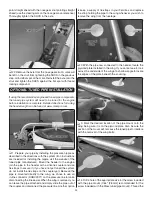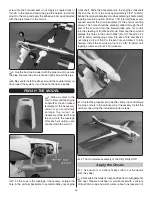
38
5) I will not fl y my model unless it is identifi ed with my name
and address or AMA number, on or in the model. Note: This
does not apply to models while being fl own indoors.
7) I will not operate models with pyrotechnics (any device that
explodes, burns, or propels a projectile of any kind).
Radio Control
1) I will have completed a successful radio equipment ground
check before the fi rst fl ight of a new or repaired model.
2) I will not fl y my model aircraft in the presence of spectators
until I become a qualified flier, unless assisted by an
experienced helper.
3) At all fl ying sites a straight or curved line(s) must be
established in front of which all fl ying takes place with the
other side for spectators. Only personnel involved with fl ying
the aircraft are allowed at or in the front of the fl ight line.
Intentional fl ying behind the fl ight line is prohibited.
4) I will operate my model using only radio control frequencies
currently allowed by the Federal Communications Commission.
5)
I will not knowingly operate my model within three miles
of any pre-existing fl ying site except in accordance with
the frequency sharing agreement listed
[in the complete
AMA Safety Code].
9) Under no circumstances may a pilot or other person touch
a powered model in fl ight;
nor should any part of the model
other than the landing gear, intentionally touch the ground,
except while landing.
CHECK LIST
During the last few moments of preparation your mind may
be elsewhere anticipating the excitement of the fi rst fl ight.
Because of this, you may be more likely to overlook certain
checks and procedures that should be performed before the
model is fl own. To help avoid this, a check list is provided to
make sure these important areas are not overlooked. Many
are covered in the instruction manual, so where appropriate,
refer to the manual for complete instructions. Be sure to
check the items off as they are completed (that’s why it’s
called a
check list!
).
❏
1. Check the C.G. according to the measurements
provided in the manual.
❏
2. Be certain the battery and receiver are securely
mounted in the fuse. Simply stuffi ng them into place
with foam rubber is not suffi cient.
❏
3. Extend your receiver antenna (if applicable).
❏
4. Balance your model
laterally
as explained in the
instructions.
❏
5. Use threadlocking compound to secure critical fasteners
such as the set screws that hold the wheel axles to the
struts, screws that hold the carburetor arm (if applicable),
screw-lock pushrod connectors, etc.
❏
6. Add a drop of oil to the axles so the wheels will turn
freely.
❏
7. Make sure all hinges are
securely
glued in place.
❏
8. Reinforce holes for wood screws with thin CA where
appropriate (servo mounting screws, cowl mounting
screws, etc.).
❏
9. Confi rm that all controls operate in the correct direction
and the throws are set up according to the manual.
❏
10. Make sure there are silicone retainers on all the clevises
and that all servo arms are secured to the servos with
the screws included with your radio.
❏
11. Secure connections between servo wires and
Y-connectors or servo extensions, and the connection
between your battery pack and the on/off switch with
vinyl tape, heat shrink tubing or special clips suitable
for that purpose.
❏
12. Make sure any servo extension cords you may have
used do not interfere with other systems (servo arms,
pushrods, etc.).
❏
13. Secure the pressure tap (if used) to the muffl er with
high temp RTV silicone, thread locking compound or
J.B. Weld.
❏
14. Make sure the fuel lines are connected and are
not kinked.
❏
15. Balance your propeller (and spare propellers).
❏
16. Tighten the propeller nut and spinner.
❏
17. Place your name, address, AMA number and telephone
number on or inside your model.
❏
18. Cycle your receiver battery pack (if necessary) and
make sure it is fully charged.
❏
19. If you wish to photograph your model, do so before
your fi rst fl ight.
❏
20. Range check your radio when you get to the
flying field.
FLYING
The Dirty Birdy ARF is a great-fl ying model that fl ies smoothly
and predictably. The Dirty Birdy does not, however, possess
the self-recovery characteristics of a primary R/C trainer and
should be fl own only by experienced R/C pilots.



































